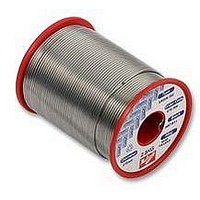NO CLEAN, CLEAR RESIDUE CORED SOLDER WIRES
Multicore Crystal solid fluxes for cored solder wires have been specially
formulated to complement No Clean wave and reflow soldering
processes. They are also applicable to repair operations carried out
after a cleaning process, eliminating the need for further cleaning.
•
•
•
•
•
•
PRODUCT RANGE
Multicore Crystal 400 is designed for users who require a halide free
formulation while Crystal 500 contains a low level of halide. The
remaining products in the range contain higher halide levels to maximise
soldering power.
Multicore Crystal 400, 500, 502, 505 and 511 cored wires are
manufactured with a range of flux contents. Although users will
normally be using products with a nominal flux content of 3%, the
superior performance of the Crystal products may allow a lower flux
content to be specified e.g 2.2%. This will further improve residue
appearance by reducing the quantity. All are available in alloys
conforming to national and international standards, including lead free
alloys. Some alloys and flux contents may be manufactured to special
order.
RECOMMENDED OPERATING CONDITIONS
Soldering iron: Good results should be obtained using a range of tip
temperatures. However, the optimum tip temperature and heat capacity
required for a hand soldering process is a function of both soldering iron
design and the nature of the task and care should be exercised to avoid
unnecessarily high tip temperatures for excessive times. A high tip
temperature will increase any tendency to flux spitting and it may
produce some residue darkening.
The soldering iron tip should be properly tinned and this may be
achieved using Multicore Crystal cored wire. Severely contaminated
soldering iron tips should first be cleaned and pre-tinned using Multicore
Tip Tinner/Cleaner TTC1, then wiped on a clean, damp sponge before
re-tinning with Crystal cored wire.
Soldering process: Multicore Crystal flux cored wires contain a careful
balance of resins and activators to provide clear residues, maximum
activity and high residue reliability, without cleaning in most situations.
To achieve the best results from Multicore Crystal solder wires,
recommended working practices for hand soldering should be observed
as follows:
Halide free version – Crystal 400
Fast soldering – range of activities to suit all applications
Good spread on copper, brass and nickel
Clear residues
Heat stable – low spitting
Mild odour
Product
•
•
•
The total process will be very rapid, depending upon thermal mass, tip
temperature and configuration and the solderability of the surfaces to be
joined.
Multicore Crystal flux cored solder wires provide fast soldering on
copper and brass surfaces as well as solder coated materials. Activity
of the halide activated versions on nickel is also good depending on the
state of oxidation of the nickel finish. The good thermal stability of
Crystal fluxes means they are also well suited to soldering applications
requiring high melting temperature alloys.
The resin and flux systems are designed to leave relatively low residues
and to minimise residual activity. This is achieved by ensuring some
decomposition and volatilisation takes place during the soldering
process. In some situations, this may generate visible fuming but in all
cases, rosin fumes must be removed from the breathing zone of
operators.
Cleaning: Multicore Crystal flux cored solder wires have been
formulated to leave pale flux residues and to resist spilling and fuming.
In most industrial and consumer electronics applications cleaning will
not be required and the produce may therefore be used to complement
a No Clean wave soldering or reflow process or to allow repairs to
cleaned boards without the need for a second cleaning process. Should
residue quantity be an important consideration, Multicore X39 flux cored
wire may be specified if a halide free product is required or X52 if halide
may be tolerated. Crystal 500, 502, 505 and 511 offer good activity and
consequently cored wire flux contents and hence residue levels may be
reduced in comparison with equivalent conventional products.
Should cleaning be required, this is best achieved using Multicore
Prozone Solvent Cleaner (separate data sheet available). Other
proprietary solvent or semi-aqueous processes may be suitable but
saponification is not recommended.
Apply the soldering iron tip to the work surface, ensuring that it
simultaneously contacts the base material and the component
termination to heat both surfaces adequately. This process should
only take a fraction of a second.
Apply Crystal flux cored solder wire to a part of the joint surface
away from the soldering iron and allow to flow sufficiently to form a
sound joint fillet – this should be virtually instantaneous. Do not
apply excessive solder or heat to the joint as this may result in dull,
gritty fillets and excessive or darkened flux residues.
Remove solder wire from the work piece and then remove the iron
tip.
TM
400, 500, 502, 505 & 511
Product Data Sheet
July 2003



